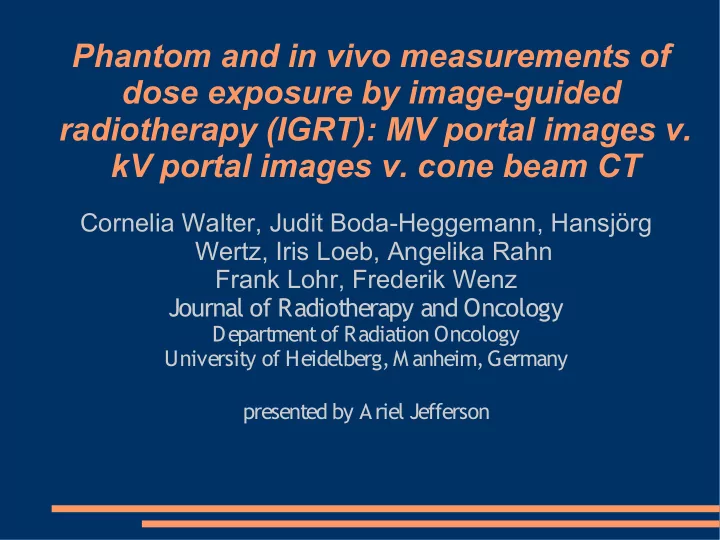

Phantom and in vivo measurements of dose exposure by image-guided radiotherapy (IGRT): MV portal images v. kV portal images v. cone beam CT Cornelia Walter, Judit Boda-Heggemann, Hansjörg Wertz, Iris Loeb, Angelika Rahn Frank Lohr, Frederik Wenz Journal of Radiotherapy and Oncology Department of Radiation Oncology University of Heidelberg, M anheim, Germany presented by Ariel Jefferson
Introduction to radiotherapy ● Definition: Radiotherapy (radiation therapy) is the treatment of cancerous cells with ionizing radiation ● High energy x-rays in the megavolt MV range – 1 photon = millions of electron volts of energy – Goal: to damage cell DNA to stop their proliferation ● How do we ensure precise delivery of the therapy beam to the cancer cells with minimal exposure to normal tissues?
Image guidance ● Take an image of internal patient anatomy before and sometimes during treatment ● Efficient imaging techniques minimize the difference between clinical target volume and planning target volume – Clinical target volume: actual site and volume of the cancerous mass – Planning target volume: created to account for tumor/organ movement or change in size
What determines the effectiveness of an imaging technique? ● High contrast ● Spatial resolution ● Low dose exposure to the patient – The most commonly used imaging techniques involve x-rays
Imaging modalities evaluated Gantry head ● MV portal image kV source and detector ● kV portal image ● Cone beam CT EPID Elekta Synergy System Linear Accelerator
MV and kV portal images Portal images – Imaging beam originates from the gantry head and is ● detected by the EPID (electronic portal imaging device) Gantry head EPID
Cone beam CT Cone beam x-ray configuration – Imaging beam originates from the online x-ray source ● which rotates detector x-ray source
A. Amer et al. “Imaging doses from the Elekta Synergy Cone beam CT system” 2007
Advantages and Disadvantages ● MV portal imaging – Uses the actual treatment beam to acquire images (standard positioning procedure) Advantage – Easy and readily available during the treatment which allows for patient repositioning if necessary Disadvantages – Provides one 2D image per acquisition – MV beams usually only detect bone, treatment usually targets soft tissue Mostafi et al patent
Advantages and Disadvantages ● kV portal imaging – Uses a lower energy version of MV x-ray Advantages – Lower energy allows for detection of soft tissue structures – Lower energy = lower absorbed dose Disadvantage – Provides a 2D image Mostafi et al patent
Advantages and Disadvantages ● Cone beam CT imaging – Uses a low energy kV x-rays www.jimoid.com Advantages – Lower energy allows for detection of soft tissue structures – CBCT apparatus rotates around the patient to obtain a 360 degree series of projections ● Once reconstructed, the projections provide a 3D volumetric image of the patient's anatomy
Questions ● Can a high contrast, spatially resolute image be acquired while limiting the radiation dose absorbed to the patient? ● More specifically, which of these imaging modalities is the most efficient for purposes of image-guided radiotherapy?
Materials and methods ● Elekta Synergy system 6 MV linear accelerator ● 5 prostate radiotherapy patients – 3 in vivo dose measurements were obtained per patient (one for each imaging modality) ● CTDI phantom for 3 cone beam CT dose measurements CTDI phantom
Materials and methods ● Quantities measured – MV portal image ● anterior/posterior and lateral dose was measured in vivo both on skin and in rectum – kV portal image ● anterior/posterior and lateral dose was measured in vivo both on skin and in rectum – Cone beam CT ● In vivo dose measured inside rectum only ● Dose inside CTDI phantom CTDI phantom
In vivo dose measurements ● A semi-flexible ionization chamber was fixed to the patient's skin – PTW 31003 – 0.3cm ³ sensitive volume ● Rectal measurements were performed with a micro-chamber – PTW 23323 – 0.1cm ³ sensitive volume
CTDI phantom measurements ● CT chamber – 3.14cm ³ measuring volume – 10cm sensitive distance ● Ionization chamber – 0.3cm³ in size ● The two chambers were irradiated over the full length so the entire irradiated volume (length > 10cm) could be measured
Results: in vivo measurements
Portal image Results Fig1. Portal images (a) kV-source 0, (b) kV-source 90, (c) M V-source 0 and (d) M V-source 90.
CBCT image results Fig. 2. (a) Transversal, (b) coronal and (c) sagittal reconstruction of a 360 ° volume scan.
CTDI phantom results ● CT chamber CTDI phantom – Avg CTDI in center: 10.2 mGy – Avg CTDI in periphery: 23.6 mGy ● From these averages, the weighted CTDI was calculated: ● Result: 19.1 mGy
CTDI phantom results ● 0.3cm ³ ionization chamber CTDI phantom – Avg CTDI in center: 11.4 mGy – Avg CTDI in periphery: 25.4 mGy ● From these averages, the weighted CTDI was calculated: ● Result: 20.7 mGy ● Both chamber measurements concur wth the in vivo measurements (17.23 mGy +/- 2.76)
Statistics ● kV portal image dose was 98-99% lower than MV – Comparing both skin and rectal dose measurements ● Cone beam CT dose was 73% lower than MV – Comparing only rectal dose
Conclusions ● Gantry-mounted kV source (kV portal imaging) is a reliable tool for fast position verification – Low dose – Better image quality ● The tested kV-cone beam CT is well suited for daily position verification – Provides critical information about 3D patient alignment
Recommend
More recommend